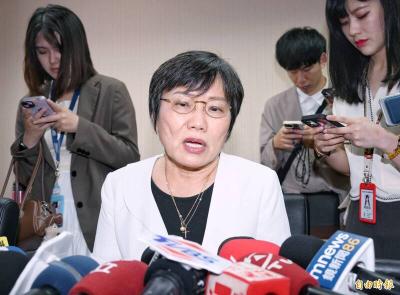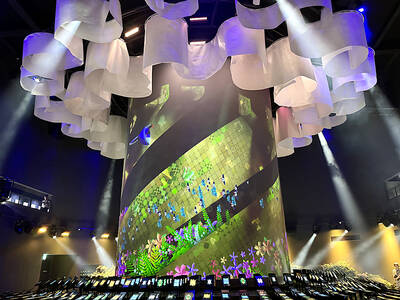Critics are divided over the Cab-inet's NT$2.6 trillion, six-year national-development project to turn Taiwan into a "green silicon island" -- a nation devoted to clean high-tech industries.
Some say the project is aimed at winning support for the Chen Shui-bian (陳水扁) administration ahead of the 2004 presidential election. Others simply argue that the project is aimed at making Taiwan a better place.
"Its purpose is clearly to win the 2004 presidential contest, because the Chen administration has to show the public that it's determined to do something to deserve another four years in power," said Norman Yin (
Chiang Ping-kun (江丙坤), legislative vice speaker and former chairman of the Cabinet's Council for Economic Planning and Development (CEPD) under the KMT, expressed the same opinion.
"It's obvious that the introduction of the six-year project serves the purpose [of winning the presidential contest]," he said.
"While Beijing will play host to the Olympic Games in 2008, the DPP-led government has to show to both the world and its people that Taiwan, too, has a promising blueprint to look forward to and that the island deserves some media attention in the international arena."
But the DPP's Chen Po-chih (
"The six-year national project is definitely not designed to win the presidential election just two years away," Chen said.
"The idea of building a `green silicon island' had already been proposed when I chaired the CEPD. As we decided the ultimate goal of the project, the rest of plan kind of fell into place."
After 76 rounds of discussion and revision, the Cabinet finally approved the project on Wednesday.
The government hopes to create 700,000 new jobs, decrease unemployment from 5 percent today to 4 percent, boost GDP growth to 5 percent annually from 2.3 percent this year and devote up to 3 percent of Taiwan's GDP to research and development.
In addition, the Cabinet hopes the project will help develop at least 15 products or technologies that will rank among the world's best, double the current number of foreign tourists from 1 million to between 2 million and 5 million and increase the household use of broadband Internet services to 6 million homes.
To ensure the full implementation of the project, Vice Premier Lin Hsin-yi (
Hu Sheng-cheng (
Chen Chi-nan (陳其南) will oversee the talent cultivation plan, the creative industry development plan and the community construction plan.
Lin Sheng-feng (林盛豐) will take charge of plans to increase the number of tourists and the water and green construction plans.
Tsai Ching-yen (
Criticizing the six-year project as "nothing new," Yin said it is nothing but a "larger-scale version of the NT$810 billion public-construction project."
The project was introduced by former premier Chang Chun-hsiung (
"I don't see many innovative ideas in the project because most of it continues the NT$810 billion public-construction project, which didn't boost Taiwan's economy but instead" exacerbated the problem, Yin said.
Although some plans included in the six-year project, such as the talent-cultivation plan and the creative industry development plan, are considered to be new, Yin said they won't do much good to spur the nation's economy.
"As the government is already suffering from financial difficulties, it should spend its money more carefully in areas that can swiftly and directly boost the local economy," he said. "I don't see that big investment in cultural and humanity industries swiftly boosting the economy."
Although Yu pledged to implement the project to the full, Yin said he is skeptical.
"Who knows whether the DPP will still remain in power and Yu will still be the premier after the 2004 presidential election?" Yin said.
Chen, however, said that although it is possible that the DPP will lose power in the future, a good national development project should be mapped out from a long-term perspective.

Chinese Nationalist Party (KMT) Chairman Eric Chu (朱立倫), spokeswoman Yang Chih-yu (楊智伃) and Legislator Hsieh Lung-chieh (謝龍介) would be summoned by police for questioning for leading an illegal assembly on Thursday evening last week, Minister of the Interior Liu Shyh-fang (劉世芳) said today. The three KMT officials led an assembly outside the Taipei City Prosecutors’ Office, a restricted area where public assembly is not allowed, protesting the questioning of several KMT staff and searches of KMT headquarters and offices in a recall petition forgery case. Chu, Yang and Hsieh are all suspected of contravening the Assembly and Parade Act (集會遊行法) by holding

PRAISE: Japanese visitor Takashi Kubota said the Taiwanese temple architecture images showcased in the AI Art Gallery were the most impressive displays he saw Taiwan does not have an official pavilion at the World Expo in Osaka, Japan, because of its diplomatic predicament, but the government-backed Tech World pavilion is drawing interest with its unique recreations of works by Taiwanese artists. The pavilion features an artificial intelligence (AI)-based art gallery showcasing works of famous Taiwanese artists from the Japanese colonial period using innovative technologies. Among its main simulated displays are Eastern gouache paintings by Chen Chin (陳進), Lin Yu-shan (林玉山) and Kuo Hsueh-hu (郭雪湖), who were the three young Taiwanese painters selected for the East Asian Painting exhibition in 1927. Gouache is a water-based

Taiwan would welcome the return of Honduras as a diplomatic ally if its next president decides to make such a move, Minister of Foreign Affairs Lin Chia-lung (林佳龍) said yesterday. “Of course, we would welcome Honduras if they want to restore diplomatic ties with Taiwan after their elections,” Lin said at a meeting of the legislature’s Foreign Affairs and National Defense Committee, when asked to comment on statements made by two of the three Honduran presidential candidates during the presidential campaign in the Central American country. Taiwan is paying close attention to the region as a whole in the wake of a

OFF-TARGET: More than 30,000 participants were expected to take part in the Games next month, but only 6,550 foreign and 19,400 Taiwanese athletes have registered Taipei city councilors yesterday blasted the organizers of next month’s World Masters Games over sudden timetable and venue changes, which they said have caused thousands of participants to back out of the international sporting event, among other organizational issues. They also cited visa delays and political interference by China as reasons many foreign athletes are requesting refunds for the event, to be held from May 17 to 30. Jointly organized by the Taipei and New Taipei City governments, the games have been rocked by numerous controversies since preparations began in 2020. Taipei City Councilor Lin Yen-feng (林延鳳) said yesterday that new measures by